Text
I promised you some lions! Let's talk about manes, males, and management.
This is Tandie, the current male lion at the Woodland Park Zoo.
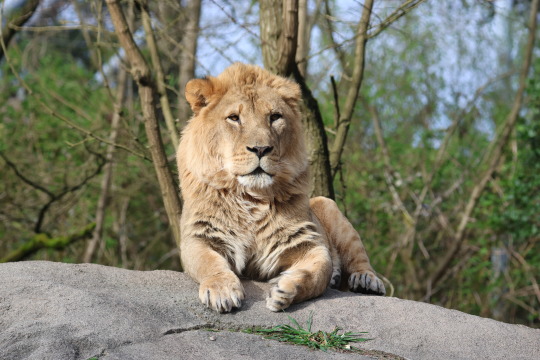
Notice anything odd about him? He's got one of those hilarious awkward teenager manes. Except... this cat is nine years old.
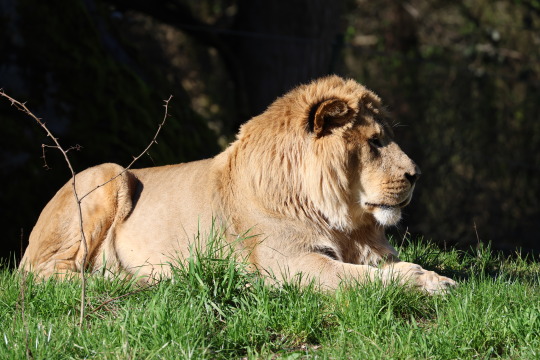
I was, of course, immediately curious.
Manes serve a lot of purposes for male lions, including being an indicator of health and fitness - it's actually a sexually selected trait and a social signal. Mane texture / hair quality / length is dependent on nutrition and the body having energy to grow (and carry around!) that much hair! The color is also a signal: males with darker manes have been found to have higher testosterone levels.
In one research report, wild males were much more likely to avoid a lion decoy when it had a longer or darker mane - but the girls really loved a dark mane. It's thought this is because a long, dark mane is an indicator of mate quality. Males with longer, darker manes have higher testosterone and were pretty healthy: meaning they had more energy for fighting, had a better chance of recovering if they got injured, and generally had a higher rate of offspring survival. Manes matter!
So, back to Tandie. He was actually born at the Woodland Park Zoo in 2014 alongside two brothers, to dad Xerxes and mother Adia.
This was Xerxes (rip).
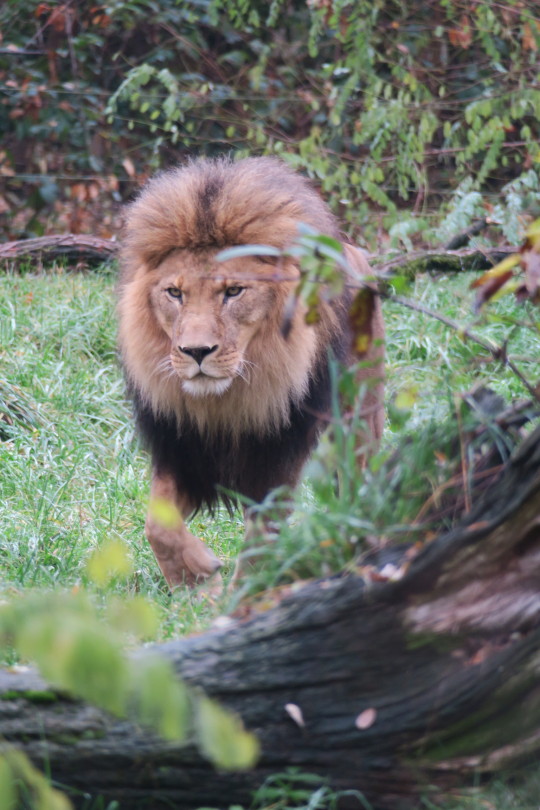
Obviously, a very large, dark, lush mane on Xerxes here. So where did these blond muttonchops come from on his son?
I asked the zoo docents and got an answer that didn't make a lot of sense. They told me that after the three cubs grew into adolescents, they were moved to the Oakland Zoo together. But living together suppressed his testosterone, and he never grew a mane.
Hmmmm.
Here's a photo from 2016, when the brothers debuted at Oakland. They're a year and a half old in this photo.
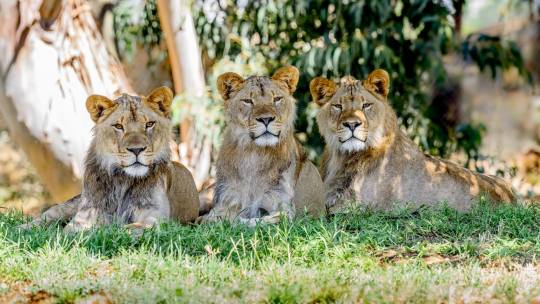
(Photo Credit: Oakland Zoo)
And here's from an announcement for their third birthday.

(Photo credit: Oakland Zoo)
Okay, so these dudes obviously all were growing manes as of 2017. I think Tandie is the one on the left in the first photo, and laying down in the middle on the second. What happened?
I was just in the Bay Area for a zoo road trip, of course I went to Oakland and tracked down a docent to ask some questions.
It turns out that shortly after the brothers turned three, they started acting like adult male lions: they started scuffling regularly. It's a normal social thing for male lions to live in groups, called coalitions, but according to my lion experts there's generally a baseline level of some social jostling within them. It wasn't quite clear from what the docent said if they couldn't manage the boys together, or if they just wanted to avoid the scratches and small wounds that result from normal lion behavior. Regardless, they put all three of the boys on testosterone blockers in order to be able to keep them together as a social group.
Now, I don't know a lot about the use of hormone alteration as a form of captive animal management, except in the case of birth control. I don't think it's something that's unethical - there was just a webinar on it that I saw go by - but I don't think it's commonly done with big cats. Lions have kind of complicated reproductive cycles, and for instance, we've been learning that female lions can take much longer to come into estrus again than expected after coming off hormonal birth control.
In males, testosterone blockers (or being neutered) means they lose their manes. This is why a lot of rescues will do a vasectomy on their males instead of a neuter - it allows them to keep their mane and the social signals that accompany it.
Tandie returned home to Woodland Park Zoo after Xerxes passed in early 2022, and the docent told me all of the lions had been off their blockers "for while." I'd guess those things happened around the same time, since bringing the trio down to a duo at Oakland would reduce some of the social tensions.
Hormones are such interesting things, though. One of Tandie's brothers has a full mane again, and the other is still totally mane-less.
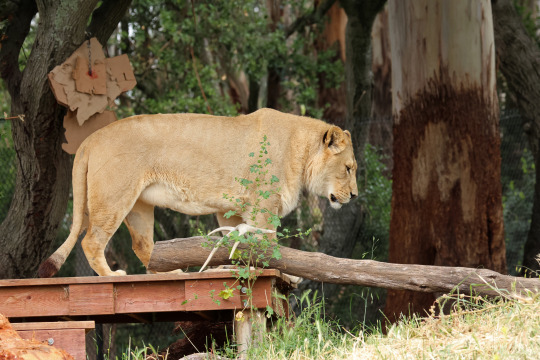
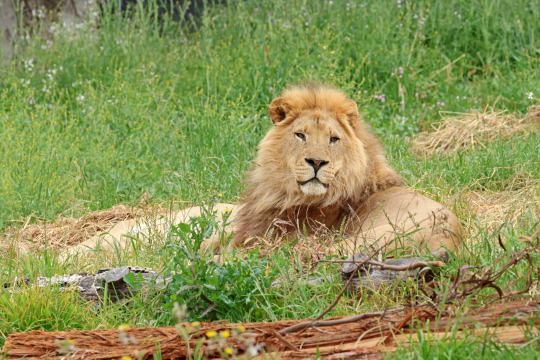
As for Tandie, his mane is growing back in, and it looks like he might rival his dad for length and coloration.
He started here, in February:

Yesterday:

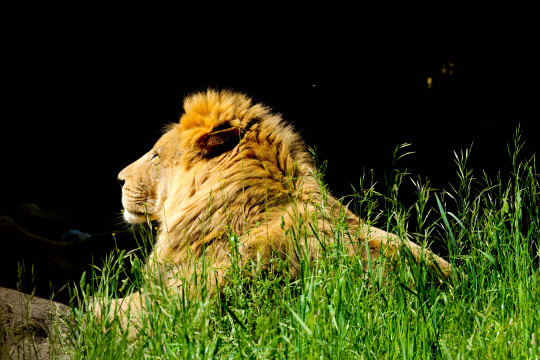
What a difference four months (and maybe proximity to a girl) makes!
#big cats#lion#african lion#big cat behavior#zoo animals#zoo animal welfare#captive animal management#zoos
3K notes
·
View notes
Text
Yesterday, I was off to the zoo to get some lion photos for an upcoming post. I checked my phone when I stopped to get gas and saw a new baby announcement: Woodland Park has a new baby pudu! He's as-of-yet-unnamed and about a month old.
Pudu, if you're not familiar with the species, are the smallest species of deer in the world. They're found in a very limited range in South America.
Needless to say, I took a very cursory turn past the lions, and then spent a couple hours camped out at the pudu habitat waiting for the fawn to venture out of his hiding spot.
It was worth it.

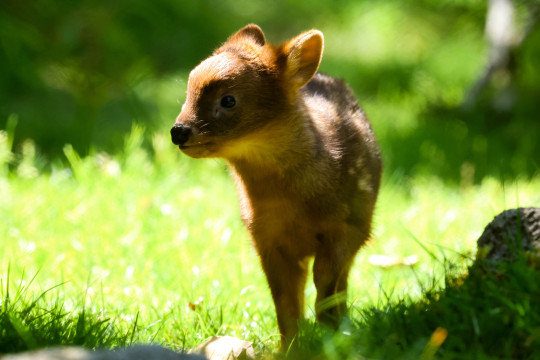
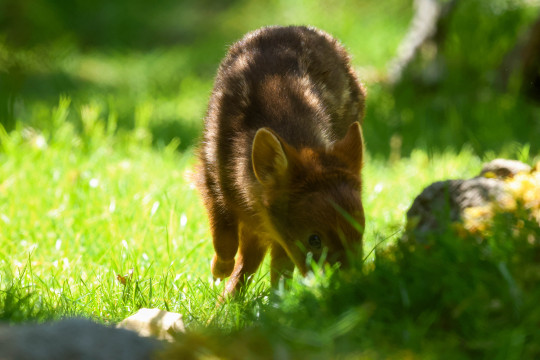

I knew pudu were small, but still. The adult in the habitat (not sure if mom or dad) was comparable in height and length to an average medium-sized dog. This guy, at a month old? He's the size of a large chihuahua.
3K notes
·
View notes
Note
My bearded dragon hates snow. He's never tasted it or been in it, and he's a perfectly healthy 4 year old male. However, when it snowed the first time since I got him, I held him up to the window and he hissed and ran up back to my chest. I thought it was a fluke, so I tried the next day and he did the same thing. I haven't done it since because I didn't want to stress him out. Any thoughts on why falling snow would mildly upset him? He likes looking out the window when it isn't snowing.
I'm not a reptile person, so I don't feel like I can give you a good answer here, but I'll post this so some of reptiblr can weigh in.
The main thing that I can think of - and this is not an expert opinion in any way - is that snow reflects a lot UV light. Beardies have a third, parietal, eye which detects the UV spectrum... maybe he's reacting to the change in stimulus? Or the fact that something familiar has changed so drastically and is reflecting light really differently?
Reptiblr, we need you!
114 notes
·
View notes
Note
Hi! I was wondering if you knew anything in particular about the Lincoln Park Zoo- I think it’s the only zoo I’ve ever been to that’s free/no admission! Especially considering the scale. The only thing that concerned me was that their polar bears seem to have a history of stereotypical behaviors (pacing, primarily) which I saw while I was there, but again, I’m a total outsider to the actual inner workings of the facility. Sorry if this is too vague, haha.
There's a couple city zoos like that with free entrance! It's a cool option, and indicative of the city providing enough funding for the facility to operate without the need for income from tickets. (Sometimes the way things are set up, I think they can be required to stay free). The St. Louis Zoo is another!
I don't know a lot about the Lincoln Park Zoo beyond what I've seen as a guest. I've gone a couple times and haven't seen anything that stood out to me as major red flags, but that's just from a public perspective and not a comprehensive assessment. They're AZA-accredited and have been for a long time, which is an indication of their general ethos and operations. I can't speak to more than that about their quality, unfortunately.
You're right about the polar bear stereotypies - that's a thing I've seen for myself. The thing is, with stereotypies - and especially with polar bears - they're not necessarily an indicator of current welfare or quality of life.
For folk who are new to the blog or unfamiliar with the concept, in animal care, a stereotypy is a "repetitive, invariant behavior pattern with no obvious goal or function." Examples often seen are repetitive pacing, head-bobbing, licking or chewing, and rocking or swaying. (It's important to note that not all repetitive behaviors are stereotypic behaviors - e.g. animals may pace when excited and anticipating the arrival of a keeper). Stereotypies can be an indicator of chronically poor welfare, under-stimulating enrichment, or inappropriate captive environments, but the important thing to know about that is that they often persist after the problem that caused them is resolved. So you can take a polar bear or an elephant that picked up a stereotypic behavior in one zoo and move them to another, much better situation, and they may still continue the stereotypy.
(The fact that stereotypies can be indicators of previous, but not current, welfare problems is a really important nuance that is often left out of discussions. Sometimes they're called "zoochosis", which anti-captivity folk define as "the psychosis induced by captivity"... but that's a very unscientific approach, and doesn't facilitate productive discussion or attempts to identify causes and alleviate the behavior. Zoochosis is nothing but a useless manipulative buzzword, folks.)
Bears in general seem to be prone to stereotypies in captive situations. I've seen some recent research that hypothesizes it's likely due to a lack of ability to engage in normal behavioral sequences, such as foraging. Polar bears seem especially prone to it. One 2013 study found that of the 55 polar bears in North America they assessed, 85% engaged in stereotypical pacing. It might be because they natural cover such a huge range in the wild that older, smaller exhibits haven't allowed them to move as much as they need to; it could also be due to a historical lack of appropriate enrichment. We don't really know, because there's so many potential factors, and the long lifespan of polar bears means longitudinal studies of multiple generations take a very long time.
These are both things the industry is working on fixing: newer polar bear exhibits are built to be much larger and more complex, and there's been a heavy focus in the literature for at least a decade on finding ways to reduce stereotypies by providing engaging enrichment and increasing bears' activity levels. Lincoln Park Zoo's polar bear habitat was renovated in 2016, and - while it looks rather boring to me, as a guest - it was apparently designed to allow for a lot of activity range and polar bear-specific needs.
Their current bears are both about 20 years old, and were transferred to the Lincoln Park Zoo after the new habitat was completed. It's entirely plausible the bears arrived with stereotypies from their previous facilities, given that the emphasis on improving polar bear care is younger than they are. Here's a photo I took there a couple years ago, of Talini (I think), engaging in a repetitive head tossing behavior. It's definitely hard to watch, as a guest, and I don't remember if they had signage up about it.
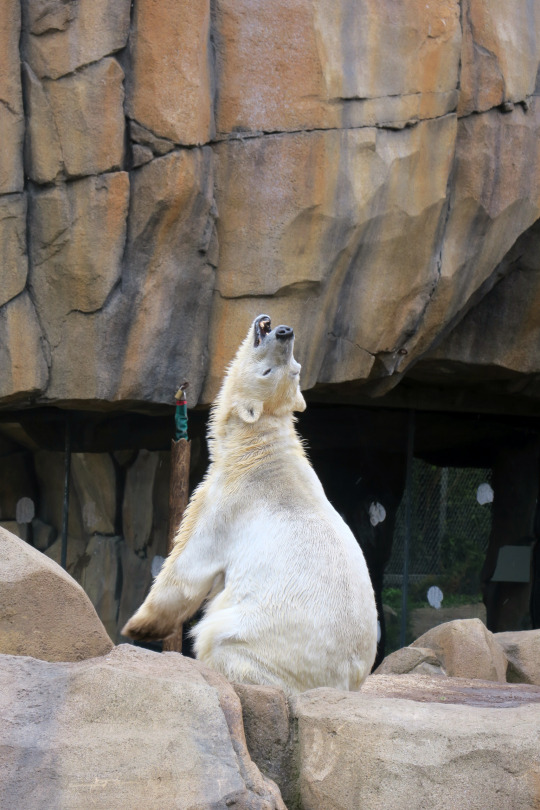
That all being said, I wouldn't judge the whole zoo based on the polar bear stereotypies, because there's so much at play there in terms of history and the evolution of care for the species. What's important is how they're handling it, and what they're doing to help encourage more normative behavior from the bears. Given the amount of research and effort the zoo field has put into addressing the topic in polar bears for the last decade, it's highly probable that a lot of staff time goes into helping reduce the amount of time those bears spend engaging in stereotypies.
201 notes
·
View notes
Text
I had a really weird moment at the Madagascar exhibit at the San Fransisco Zoo... that I can't remember the last time I've heard a child sing "I like to move it move it" at the ringtailed lemurs. While it was always annoying, I guess the absence of that sound must be an indicator I'm a Real Adult now with out-of-date cultural references. lol.
Anyhow, I'm here to talk to you about my favorite buddies from that movie - the fossa. Pronounced correctly as either "FOS-sah" or "FOO-sah", afaik.
Remember these guys, the bumbling villains of the first Madacasgar movie?
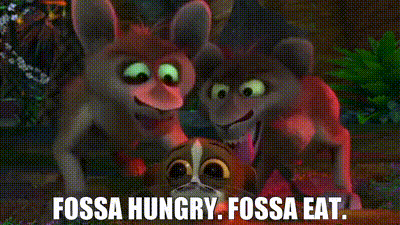
This movie did them dirty. They're such a cool species, and far more dignified than this!
Fossa are the largest carnivore on Madagascar, and hail from a group of carnivores only found on the island. They're lithe, cat-like creatures that aren't super related to cats, that look like you mixed in a weasel and maybe an otter; they're actually most closely related to civets and mongoose. They're sleek and very strong for the fact they're only a couple of feet long (not counting the very long tail). Highly mobile wrists that let them climb down trees headfirst and navigate the treetops to hunt arboreal prey.
Anyway, I'm in love. Here's the beautiful lady from the SF zoo.


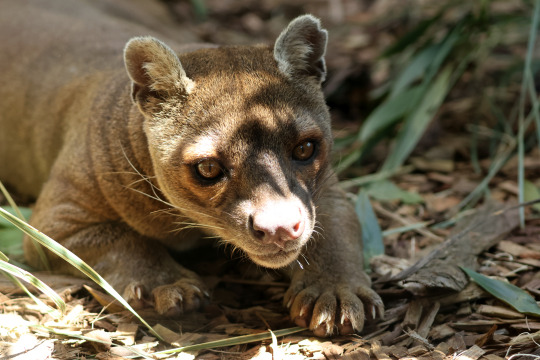
2K notes
·
View notes
Note
I know from your posts that one of your frequent zoos is Woodland Park; can you tell me what the parking situation looks like these days? The last time I was there was well over a decade ago, and parking was nearly impossible to find.
There’s multiple lots, on two sides of the zoo. They aren’t huge, but unless you’re coming on a busy weekend mid-day I haven’t had a hard time finding parking. They’re all pay parking, unfortunately. There’s also a lot of street parking, which tends to be available, but it’s a bit of a hike in if you get too far away.
33 notes
·
View notes
Text
Also, folk, I should reiterate: if I get something wrong about accessibility or leave details of a facility out? I 110% want you to tell me in whatever way is comfortable for you.
I’m not the expert here - I can only speak to my disability and my experience. I just happen to have the time and ability to do the thing for this project. So please, consider this an invitation to ask questions, add more detail, or give me a heads up something is incorrect.
#this is about zoo accessibility specifically but everything else I do too#dialogue is important and this blog is successful because so many people weigh in and contribute#we don’t shame people here for wanting to know things or being excited about stuff
147 notes
·
View notes
Text
Boosting this again! I always want to hear from people about their accessibility experiences at zoos in the US.
The way this spreadsheet works is that your comments are actively invited for any white column, all of which are labeled as "[topic] notes". The gray columns contain information provided directly by a facility. You can comment on the google sheet itself, reply to this thread, or send an ask or a message to WADTT.
Please tell me explicitly if you don't want your comments added to the spreadsheet as a direct (but anonymous) quotes. One goal is for this project is that zoos will be able to read direct feedback from their guests and learn from it, so I try to include as much direct feedback as possible, in your own words.
The types of comments that are the most useful are things a potential visitor can't learn online. Where do you get stuck in a wheelchair and can't turn around? Do the rides make loud noises? Where do you go to ask for help if you need it? If an example helps, here's the notes I just wrote up on my accessibility experiences visiting multiple zoos in California.
Also, you don't have to give me specific dates for your zoo visits. I asked for that to try to keep information current - just let me know if it was more than a year ago.
There's a lot of zoos listed that don't have their gray columns filled in yet - you're still welcome to add comments to those ones! Take the time to populate this spreadsheet takes a lot of time/computer stamina, so those will get filled out as soon as I have a chance. The feedback from people who have been is welcome whenever! And helps motivate me to flesh out those zoos, heh.
Okay, this is super preliminary, but since we've been talking about zoo accessibility I wanted to launch a project I've been planning for a couple months.
One of the hardest things about visiting zoological facilities when disabled is the lack of knowledge ahead of time, right? Often the information on the zoo's website about accessibility doesn't contain everything folk need to know to plan a visit. I think we can probably help fix that, even if it's with just crowd-sourced knowledge!
This is a google spreadsheet for recording accessibility information for various zoos. It is super unfinished right now, FYI. That's partially because I need to fill in more of it from my own experiences, and partially because there are things I didn't note or experience - which I'd love for y'all to chime in about.
Categories for the spreadsheet so far include rentable assistance options, service dog information, accessible bathroom locations, mobility, vision, auditory and sensory issues (or accommodations), food allergy options, and general notes. I'm also including the information each zoo website provides, and guest assistance phone numbers, so all the information is in one place.
To add to this crowd-sourced zoo accessibility resource:
Send an ask to the blog, or comment on the appropriate cel on the spreadsheet (if the facility you want to comment on is already listed).
Provide the name of the zoo/aquarium/sanctuary and the approximate date you visited.
Tell me your experiences / information, and what categories they belong in.
Feel free to submit photos, if that's useful info! I'm going to see if I can find a way to host them and link in the spreadsheet.
I'll take information as it's submitted and integrate it into the sheet. If the zoo you've visited isn't on the list yet, I still want to add it! This resource is going to stay US-based, however. (I just don't have the capacity to manage an international one).
Obviously, I can't personally verify everything people submit, so this is very much a resource and not a definitive guide. Date stamps are crucial important for keeping track of what's recent and what might have been updated since someone visited.
Let's make zoo, aquarium, and sanctuary visits more accessible for everyone!
2K notes
·
View notes
Text
California zoo accessibility data dump
I just recently got back from a short (and fully covid-cautious) zoo road trip in Oregon and California, and wanted to share my notes re: accessibility at the facilities I visited. I'll get this all integrated into the spreadsheet, too.
Wildlife Safari - Winston, Oregon
This is a large drive-thru safari park with a free walk-about area attached that contains some small exhibits. Guests stay inside their cars the entire drive-thru, although there's at least one place to stop and sit in a gazebo to rest and use the bathroom (porta-potty only). You can pull over to watch animals for longer, and go through multiple times if you missed anything. It's a long drive-thru and there isn't really a good way to truncate the experience if you've got some kind of emergency. The roads are not flat, but they're well maintained and not bumpy.
The walkabout area is very small and contains bathrooms, food options, and other guest services. The paths are mostly concrete and well tended, although you do have to cross the steam train tracks to get to lion/some of the lemur viewing. I believe the Australia walkabout area was also unpaved. There's lots of parking in a big, flat, paved lot.
Sacramento Zoo - Sacramento, CA
This is a very cute, small inner-city facility - a good option if you don't want to try to walk a huge zoo in one day. There's lots of shade from all the plants and a good amount of benches throughout, including picnic tables with shade canopies. The paths are almost entirely flat and paved, with the exception of a boardwalk ramp up to the giraffe feeding and okapi viewing platforms. The cafe has gluten-free and vegetarian listings (maybe vegan?) on their menu. No straws are provided for animal safety, but if you need one, they can give you a reusable curly-straw from the slushies (kinda long and awkward for a normal cup) as an accommodation. They've got both water fountains and water bottle filling stations. Being build in a larger city park and recreation complex, there isn't a dedicated parking lot just for the zoo: the closest is across the street, shared with another attraction, and is kinda small. I've never had issues finding parking when I've gone, but sometimes it does involve a bunch of walking to get to the zoo entrance - if you have mobility or stamina limitations, probably best to get dropped off at the entrance and wait (there are benches).
San Francisco Zoo - San Francisco, CA
The SF Zoo is huge. There's lots of green / garden / swamp space that doesn't have habitats in it, but it means exhibits can be pretty far away, so plan your route accordingly. (Going out to the grizzly bears is the longest loop). Depending on the time of day, there's not always a ton of shade for guests either. There's a decent amount of benches, and quite a few are in decent proximity to animal viewing. After a somewhat long but not steep hill right at the entrance, the paths are all paved and fairly flat. There's a hill going down into/up from the Australia area / kids playground, but it's the only one I really noticed. There's a long elevated boardwalk through the lemur habitats that connects to the top of the new Madagascar construction - if you can't do stairs, as of Spring 2024, that's the only way to get up there to look down on the mandrills or see the top of the fossa habitat. (It's still under construction, so there might be an elevator in the building in the future). Back by the grizzlies, there's an old indoor rainforest building - while there's buttons to automatically open the door going in, I didn't find any on the first inside door going out. It makes sense they don't want both doors to open at once since it's a bird airlock, but not having independent ones on each door meant the day I used an ECV I got stuck in there until a nice staff member noticed.
All three times I've ever been to SF most of the little food kiosks haven't been open, and the vending machines for drinks have been hit and miss - so bring your own, or stock up at the cafe if you need to have supplies with you - but there are water fountains and water bottle filling stations around the zoo. There are interpretive audio boxes through the zoo in English and Spanish, used with a key you get at the entrance(?), but I heard a lot of complaints in passing about some of them not working. There's lots of parking at the zoo in a flat paved lot, and there's a specific dropoff area on one side for rideshares/mobility needs.
Oakland Zoo - Oakland, CA
To be clear up front - Oakland was the hardest facility to visit on this whole trip, with regards to mobility. We went twice, and I used an ECV (electric scooter) one and walked the other. Neither option was easy and both were exhausting. Oakland is a super hilly facility - you basically have to drive up a major hill to get to the zoo. The bottom half of the lower zoo can only be reached by going down pretty steep paths. The hills are also not graded to be "flat", so if you're in a wheelchair or ECV, you're going to have to lean to compensate for the tilt and balance the chair... while controlling it going down a steep hill. It's exhausting and kinda scary. (I don't even let other people carry my camera because $$, but I had to ask for help so I could focus on driving the ECV on those hills). There's also a lot of areas of the pathways that are not in the best repair, or patterned with pressed-in images, and multiple places actually have brass bugs embedded in the pavement so that they stick out above the surface. Lots of tripping hazards and/or things to rattle your teeth out rolling over. A couple places in the upper zoo (the California wilds area) the paths switch from paved to sand and back again, for drainage, maybe? On the upside, there's a lot of benches everywhere, including directly across from prime viewing areas.
Getting up to the upper zoo requires using a gondola - there's no walking option. You can actually take wheelchairs and ECVs on these, but you have to be ready to advocate for yourself. Normally, they don't stop the carriages completely, and expect people to walk on while they're still moving slowly. You can ask them to slow them down for you (I did, because knee issues plus torque is bad), or stop it completely if you need the time/help. When I took an ECV on, they had me disembark and get in one carriage, and they loaded it into the subsequent ones. This is fine because I can walk and stand on concrete for a while without it, but I'm not sure how that practice would work for people who need their mobility aids the whole time. They were very nice about managing the stopping and the loading and didn't make it feel like an imposition, too. If they stop the carriages completely at any point, there will be a loud buzzer/alarm when the ride starts back up. If you're close, it's pretty loud and startling. As they leave the track at the bottom the gondolas tip and dip a little, which can be scary if you're not expecting it - I think it's just the transition of the car from the loading bay onto the track itself. The rest of the ride is very smooth. The track is pretty high up and gives a great view of the bay and the surrounding cities, but face uphill if you don't do well with heights. Once at the upper zoo, the path from bald eagles through jaguar is mostly a boardwalk, but it's not too bumpy.
Oakland's parking is hard if you're not there early in the day, IMO. The overflow parking gets pretty far from the entrance, and starts to go up the hill towards the upper zoo. If the lot looks busy, drop anyone with mobility/stamina issues off at the entrance before parking. Unlike many other zoos I've visited, Oakland's ECVS have added sunshades, which is really nice (and which I should have used).
Monterey Zoo - Salinas, CA
This is a fairly small facility with most habitats on one level, but some big cats and bears are up a pretty big hill. The walkways are paved and flat, and there's an ADA-graded boardwalk ramp that takes you to the top of the hill. The pipes used for the handrails on both the stairs and the ramp get very hot in the sun, however. There's a boardwalk up to the rhino overlook. They indicate that their bathrooms are accessible, but the ones in the main building didn't have bars for transferring - I didn't check the ones up on the hill. At one point in the day speakers along the path started playing really loud pop music (drowned out the birds) and it was very overwhelming. There's lots of handicapped parking spots across from the front entrance, but if you don't have a tag, the rest of the spots are up a bit of a hill and a small walk from the entrance. They do have a note, though, that they can help if you need accessible parking and don't see any, so you could probably call/have someone to go in and ask for an accommodation.
Sequoia Park Zoo - Eureka, CA
This is another nice small facility, very doable for a half-day trip. The paths are paved and flat, and there's benches available. There's a lot of shade, although it can depend on the time of day, and places to fill a water-bottle. The sky-walk through the redwoods is accessible, but might be a little difficult depending on mobility limitations - its' a very sturdy boardwalk through the canopy of the tall trees. (I had more thoughts on this from my last visit, I'll dig out those notes). If you can do even part of it, it's worth it, and there's places to turn around. Because it's in a residential area of the town there's not a huge dedicated parking lot, but lots of street parking and a decent lot directly across the street. I've never had difficulty finding parking, and you can drop people off at the entrance easily.
#accessibility project#zoo accessibility#my notes#zoo accessibility project#disability rights#disability access#ada compliance
160 notes
·
View notes
Text
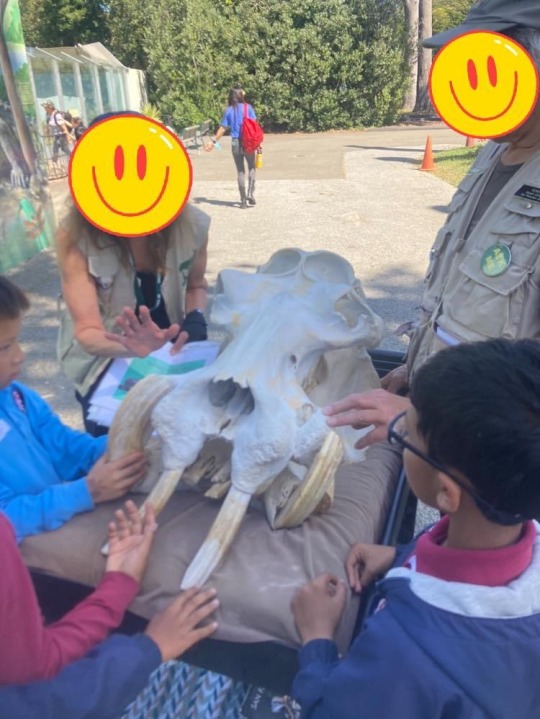
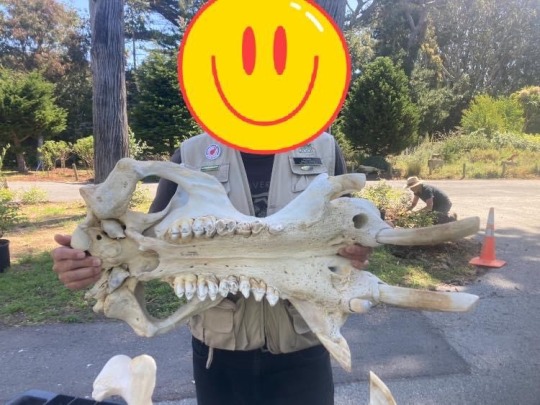


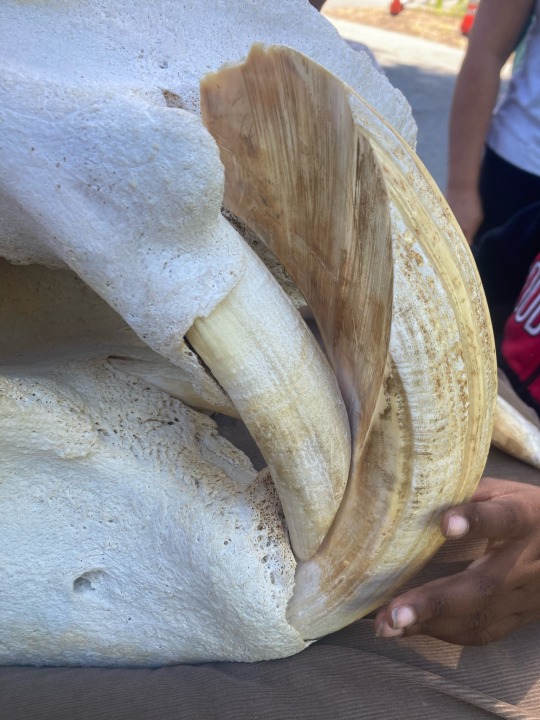
Super cool docent cart at the San Francisco Zoo today! This Nile hippopotamus was a previous zoo resident and his skull is now helping educate guests.
I’ve never see a hippo skull irl, much less gotten to touch their ivory, so I spent a ton of time talking with them. I’ve been super impressed with all the docents I’ve encountered here!
410 notes
·
View notes
Text
Thanks to everyone who has shared their perspective! I have some follow up queries:
- If printing something ahead is an equity issue re: access to printers, would ticket booths or gift shops having a “print on demand” option be a reasonable solution? Would it matter if this made the map B&W versus an online version?
- Low vision folk, can screen readers handle online maps at all? Are paper maps a useful tool for you? What sort of map would ideally work best for your visit?
- Follow-up low vision question, what happens when you try to use assistive tech on a QR code image/link?
- How much risk is there that something nasty can get stuck in an zoo’s QR code without them knowing? That sort of concern is way beyond my tech knowledge.
- For folk with family with low/no English fluency, how much does physical signage like maps with images impact their your visit?
- How does changing maps like this impact people visiting with caretakers or assistants? Is it normal for people assisting disabled individuals in a professional capacity to need to use their personal devices as part of the job? Again, this is outside my scope of knowledge but I’m curious if there’s relevance.
I’ve got some accessibility questions around zoo maps! Specifically, I’m interested in how people are impacted by the lack of paper maps / digitization of maps, especially when the ones in other languages than English are only online.
Please chime in in the replies and tell me about accessibility impacts you’ve experienced (or know someone who has experience) with:
No paper map policies
Online-only maps
QR codes to access maps
Maps available in an app only
Policies that instruct visitors to print their own maps ahead of time at home
Being told to photograph big signs with maps on them throughout the zoo in lieu of using an online map
Non-English maps being available online only
Policies that guests should use an app / Google translate to access map information / signage
I’ve got my own thoughts, but I know my perspective is limited to my personal experience. If these policies impact you in any way - not just due to disability - please tell me how. TIA!
#zoo accessibility project#zoo accessibility#disability rights#disability#zoo maps#zoo visits#crowdfunding#even if someone said it already I want to hear your experience
488 notes
·
View notes
Text
I’ve got some accessibility questions around zoo maps! Specifically, I’m interested in how people are impacted by the lack of paper maps / digitization of maps, especially when the ones in other languages than English are only online.
Please chime in in the replies and tell me about accessibility impacts you’ve experienced (or know someone who has experience) with:
No paper map policies
Online-only maps
QR codes to access maps
Maps available in an app only
Policies that instruct visitors to print their own maps ahead of time at home
Being told to photograph big signs with maps on them throughout the zoo in lieu of using an online map
Non-English maps being available online only
Policies that guests should use an app / Google translate to access map information / signage
I’ve got my own thoughts, but I know my perspective is limited to my personal experience. If these policies impact you in any way - not just due to disability - please tell me how. TIA!
#zoo accessibility#zoo accessibility project#zoos#accessibility#crowdsourcing#disability#disability rights
488 notes
·
View notes
Text


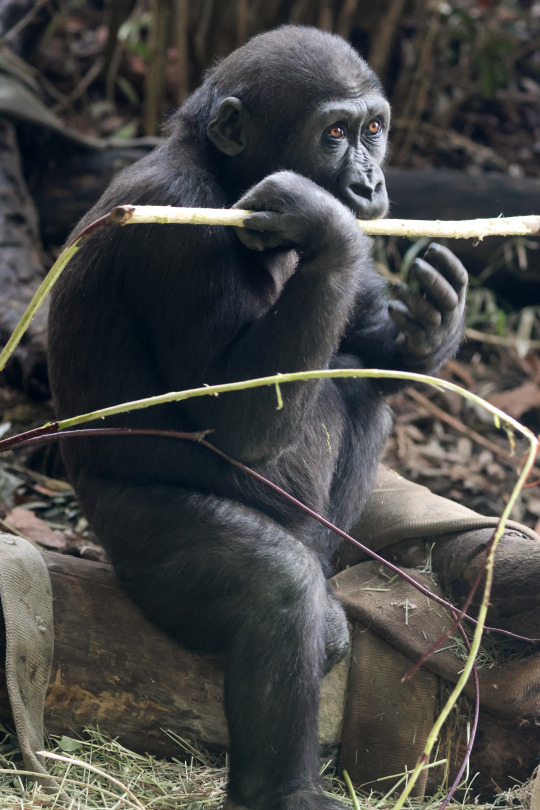
Going through photo folders to find images for the references project, and I came upon a couple photos of the juvenile gorillas at Woodland Park I'd forgotten I'd taken. They've got two littles in this family group, close to the same age: Kitoko, a male, and Juna, his younger half-sister. I don't know them well enough to tell them apart so I can't ID these photos, but regardless, they were a lovely surprise to find in my files and I wanted to share.
(Shameless plug for more of my photography on Instagram)
175 notes
·
View notes
Note
If you don’t mind sharing, since you don’t work for a zoo what is your job situation like? Making a living while working at a definitely zoo seems tricky. Is your main income zoology/animal related or is that more of a side thing?
Sincerely,
- a curious zoology student
I have a (mostly) unrelated jobjob - I’ve never actually been affiliated with a single facility, unless you count college internships before I started this blog. I freelance, working as a science media fact-checker and taking paid research contracts occasionally. I do work on a lot of animal / biology related fact-check content, but it’s not my entire scope of work. I also have the privilege of having family assistance, as I have chronic health issues that interfere with the normative 9-5 grind.
Everything I do in terms of blog writing/research, zoo industry research and publication, and photography is unpaid and pretty much a hobby at this point.
Prior to the pandemic I was trying to find funding for the intra-industry research and public-facing outreach I was doing, but there was never any money for it. (The industry is very used to expecting labor from young women for free. There was and is a lot of interest in the work I do, but the number of people/orgs that have ever provided compensation or financial support is in the single digits). The pandemic actually gave me the chance to pivot to focusing on professional fact-checking.
The only funding I get for any of this work is through a somewhat defunct Patreon I set up years ago when I was trying to make this blog / scicomm a full time gig. I’m terrible at updating it, and I’m conflicted enough about that to have been considering deleting it entirely. (For those of you who have stuck it out despite the radio silence, you’re incredible. You’ve facilitated the donation of my time to write a really cool paper with a zoo disaster response org, which will hopefully get through peer review soon).
To make something like this blog and everything else I do in the field actually financially sustainable, I’d need to fundraise and market more. The thing about a fact-checking career, though, is that it’s reinforced the need to make sure everything I write/say publicly is completely and 100% correct - because that level of rigor is what supports my professional reputation! Which means I’m slow to produce research and reticent to talk about it before it’s finished. My work comes out all the better for it, but it doesn’t fit into a content model that produces revenue.
So yeah, all of this is a side thing that I fit in around my paid work and my health. Because sometimes I just need to go see a tiger and smell an elephant, y’know?
#personal information#zoo job almost always require multiple incomes or family support#or generational wealth#otherwise you live in poverty#I am on a very non traditional industry path and it definitely does not pay either#but it’s a passion project
149 notes
·
View notes
Note
Woodland Park Zoo has a program to supply its herbivores with different kinds of plant browse that's grown on-site-in addition to more traditional vegetable produce-which is stashed fresh daily in different areas of their enclosures to encourage foraging behaviors. I was curious if you had any thoughts or even found it notable
It isn’t really notable, but that’s a good thing! It means lots of zoos are using it to enrich their animals’ lives. Browse is really important enrichment for herbivores because so much I’d their normal activity budget is dedicated to finding and eating food - and it’s generally low enough calorie that they don’t need to be limited on how much they can have.
Some facilities even take donations of browse from local communities when trees are trimmed or cut down! After very carefully vetting them for pesticides or other health risks, of course.
113 notes
·
View notes
Note
I forget what zoo you work for, but I had the pleasure of visiting the Oakland Park zoo with my friends the other day, and it was in part thanks to you! We were originally going to go to the SF Zoo, since it was closer and we didn't know any better, but, remembering all your posts about AZA accreditation got me to look more deeply into both the SF and Oakland zoos, and we decided to switch to the Oakland Zoo instead! Which, according to everyone we've talked to, is apparently the significantly superior experience, and I'd believe it!
I don’t work for any zoo, actually (combination of wanting to think outside the box, disability, and the fact basically none of them pay a living wage). But thank you!
Oakland and San Francisco are drastically different experiences, but from a guest perspective personally I haven’t felt like one is better than other. (Although man. SF just had some major drama drop that calls a lot of management into question, I should write that up soon).
I’m glad you enjoyed your visit!
73 notes
·
View notes
Text
He apparently lost it due to injury when he was very little. I can’t find more details from either WPZ or the Audubon Zoo, where he was born.
The Woodland Park Zoo had a spring event this past weekend, which I had to hit up for the fun enrichment. My favorite of all is the maned wolves - who you rarely ever get such a good chance to see!
One moment, they're elegant and ethereal. Then there's enrichment, and you realize they're just long-legged stinky goofballs [affectionate].
Meet Rosario (with tail) and Urso (tail-less).
Elegant, ethereal, unreal:
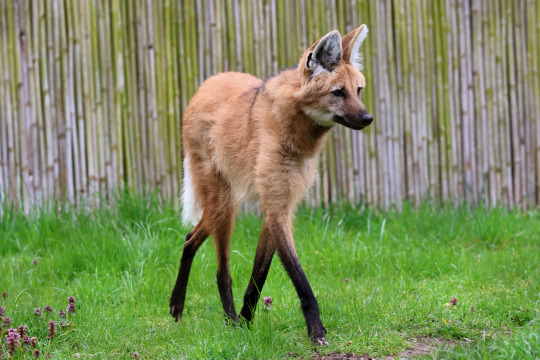

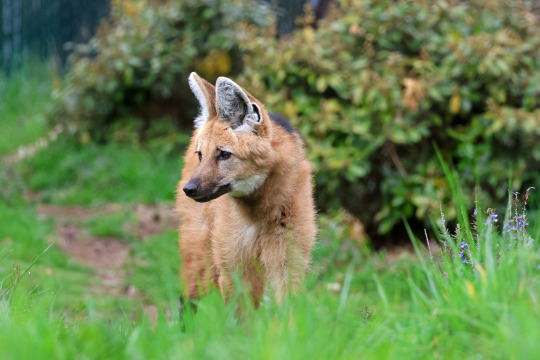


Ridiculous, adorable, dogs-running-fox-software:

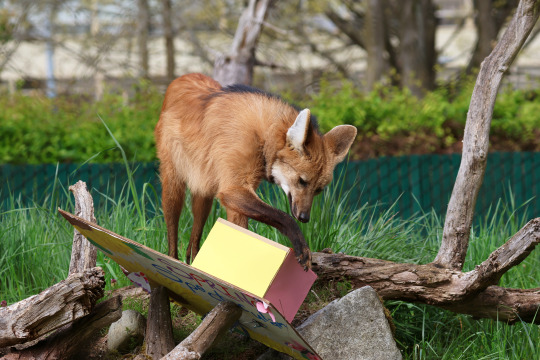

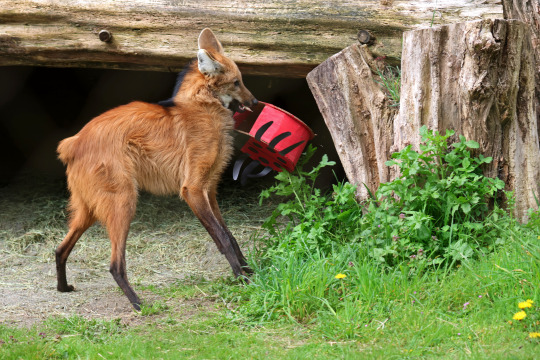

2K notes
·
View notes